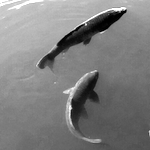Bats perform powered flight using membrane wings and have astonishing manoeuvring and flying capabilities. Understanding the complex interaction of their flight kinematics and membrane wings is critical to enhancing current biologically inspired flying vehicles and efficient bio-locomotion.
Besides the fact that bats use membrane wings, their kinematics differ significantly from other fliers; in particular, we show that many bats fly at Strouhal numbers well above the range typically associated with optimal locomotion. The reason for this shift has not yet been associated with any kinematic features or structural influence from the membrane wing. Additionally, the exact contributions of the membrane's elasticity to flight performance are unclear. This study uses high-resolution fully-coupled computational fluid-structure interaction simulations of a bat wing with controllable kinematic and material models to investigate these fundamental questions. This allows us to study the effects of the Strouhal number and the material properties of the bat wing's membrane independently. We show that the high Strouhal number of bats corresponds to a peak in aerodynamic efficiencies and that the location of this peak is relatively insensitive to the elasticity of the wing's membrane. We also show that reducing membrane elasticity is associated with improved propulsive efficiency until the membrane flutters, penalising the aerodynamic efficiencies. Finally, we demonstrate that when these membranes incorporate microstructurally and loading-induced anisotropy (i.e. fibre reinforcement), it enables a tenfold reduction of the flutter energy and maintains high aerodynamic efficiency.
|
|
|
|
High-performance bat flight simulations using parametric kinematic and material models
1 : TU Delft, Mechanical Engineering
2 : University of Southampton
|

 PDF version
PDF version
